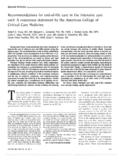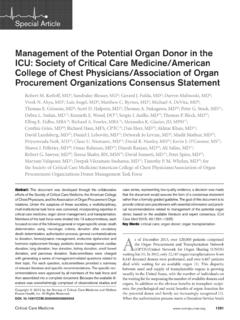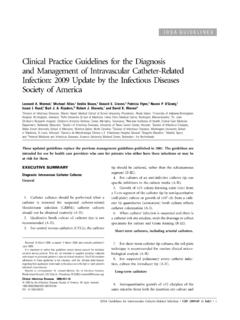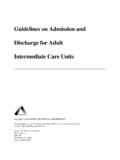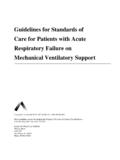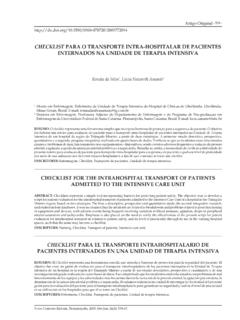Transcription of Special Articles - LearnICU.org
1 Special Articles Guidelines for the inter- and intrahospital transport of critically ill patients*. Jonathan Warren, MD, FCCM, FCCP; Robert E. Fromm Jr, MD, MPH, MS; Richard A. Orr, MD;. Leo C. Rotello, MD, FCCM, FCCP, FACP; H. Mathilda Horst, MD, FCCM; American College of Critical Care Medicine Objective: The development of practice guidelines for the con- a) pretransport coordination and communication; b) transport duct of intra- and interhospital transport of the critically ill pa- personnel; c) transport equipment; d) monitoring during transport ;. tient. and e) documentation. The transport plan should be developed by Data Source: Expert opinion and a search of Index Medicus a multidisciplinary team and should be evaluated and refined from January 1986 through October 2001 provided the basis for regularly using a standard quality improvement process.
2 These guidelines. A task force of experts in the field of patient Conclusion: The transport of critically ill patients carries in- transport provided personal experience and expert opinion. herent risks. These guidelines promote measures to ensure safe Study Selection and Data Extraction: Several prospective and patient transport . Although both intra- and interhospital transport clinical outcome studies were found. However, much of the pub- must comply with regulations, we believe that patient safety is lished data comes from retrospective reviews and anecdotal enhanced during transport by establishing an organized, efficient reports. Experience and consensus opinion form the basis of process supported by appropriate equipment and personnel. (Crit much of these guidelines.)
3 Care Med 2004; 32:256 262). Results of Data Synthesis: Each hospital should have a for- KEY WORDS: intrahospital transport ; interhospital transport ; crit- malized plan for intra- and interhospital transport that addresses ical care; health planning; policy making; monitoring; standards T he decision to transport a crit- it may require transfer to another hospi- specially trained individuals. Since there ically ill patient, either within tal. If a diagnostic test or procedural in- will almost certainly be situations when a a hospital or to another facil- tervention under consideration is un- specialized team is not available for inter- ity, is based on an assessment likely to alter the management or hospital transport , each referring and ter- of the potential benefits of transport outcome of that patient, then the need tiary institution must develop contingency weighed against the potential risks.
4 Crit- for transport must be questioned. When plans using locally available resources for ically ill patients are transported to alter- feasible and safe, diagnostic testing or those instances when the referring facility nate locations to obtain additional care, simple procedures in unstable or poten- cannot perform the transport . A compre- whether technical, cognitive, or proce- tially unstable patients often can be per- hensive and effective interhospital transfer dural, that is not available at the existing formed at the bedside in the intensive plan can be developed using a systematic location. Provision of this additional care care unit (1, 2). Financial considerations approach comprised of four critical ele- may require patient transport to a diag- are not a factor when contemplating ments: a) A multidisciplinary team of phy- nostic department, operating room, or moving a critically ill patient.
5 Sicians, nurses, respiratory therapists, hos- specialized care unit within a hospital, or Critically ill patients are at increased pital administration, and the local risk of morbidity and mortality during emergency medical service is formed to transport (3 17). Risk can be minimized plan and coordinate the process; b) the *See also p. 305. and outcomes improved with careful team conducts a needs assessment of the From Northwest Community Hospital, Arlington Heights, IL (JW); Baylor College of Medicine, Houston, TX. planning, the use of appropriately quali- facility that focuses on patient demograph- (REF); Children's Hospital of Pittsburgh, University of Pitts- fied personnel, and selection and avail- ics, transfer volume, transfer patterns, and burgh School of Medicine, Pittsburgh, PA (RAO); Subur- ability of appropriate equipment (16 37).
6 Available resources (personnel, equipment, ban Hospital, Bethesda, MD (LCR); Henry Ford Hospital, During transport , there is no hiatus in emergency medical service, communica- Detroit, MI (HMH). These guidelines have been developed by the Amer- the monitoring or maintenance of a pa- tion); c) with this data, a written standard- ican College of Critical Care Medicine and the Society of tient's vital functions. Furthermore, the ized transfer plan is developed and imple- Critical Care Medicine. These guidelines reflect the official accompanying personnel and equipment mented; and d) the transfer plan is opinion of the Society of Critical Care Medicine and do not are selected by training to provide for any evaluated and refined regularly using a necessarily reflect, and should not be construed to reflect, the views of certification bodies, regulatory agencies, or ongoing or anticipated acute care needs standard quality improvement process.
7 Other medical review organizations. of the patient. This document outlines the minimum Copyright 2004 by Lippincott Williams & Wilkins Ideally, all critical care transports, both recommendations for transport of the DOI: inter- and intrahospital , are performed by critically ill patient. Detailed guidelines 256 Crit Care Med 2004 Vol. 32, No. 1. targeted to the transport of infants and apy, hospital security) then are notified as ensured. All battery-operated equipment children have been published by the to the timing of the transport and the is fully charged and capable of function- American Academy of Pediatrics (23). In- equipment support that will be needed. ing for the duration of the transport . If a stitutions performing commercial or or- The responsible physician is made aware physician will not be accompanying the ganized interhospital transports are re- of the transport .
8 Documentation in the patient during transport , protocols must quired to function at and meet a higher medical record includes the indications be in place to permit the administration standard, as the requirements for orga- for transport and patient status through- of these medications and fluids by appro- nized transport services are considerably out the time away from the unit of origin. priately trained personnel under emer- more rigorous than the recommenda- Accompanying Personnel. It is gency circumstances. tions in this guideline (24, 38 41). strongly recommended that a minimum of In many hospitals, pediatric patients The references for this guideline were two people accompany a critically ill pa- share diagnostic and procedural facilities obtained from a review of Index Medicus tient.
9 * One of the accompanying personnel with adult patients. Under these circum- (see key words) from January 1986 is usually a nurse who has completed a stances, a complete set of pediatric resus- through October 2001 and are catego- competency-based orientation and has met citation equipment and medications will rized according to the degree of evidence- previously described standards for critical accompany infants and children during based data employed. The specific cate- care nurses (42, 43). Additional personnel transport and also will be available in the gory assigned to each reference is noted may include a respiratory therapist, regis- diagnostic or procedure area. in the References at the end of this arti- tered nurse, or critical care technician as For practical reasons, bag-valve venti- cle.
10 The letter a denotes a randomized, needed. It is strongly recommended that a lation is most commonly employed dur- prospective controlled investigation; b physician with training in airway manage- ing intrahospital transports. Portable me- denotes a nonrandomized, concurrent, or ment and advanced cardiac life support, chanical ventilators are gaining historical cohort investigation; c denotes and critical care training or equivalent, ac- increasing popularity in this arena, as a peer-reviewed state-of-the-art article , company unstable patients.* When the pro- they more reliably administer prescribed review article , editorial, or substantial cedure is anticipated to be lengthy and the minute ventilation and desired oxygen case series; and d denotes a non-peer- receiving location is staffed by appropri- concentrations.




